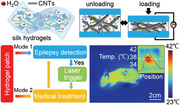- Record: found
- Abstract: found
- Article: found
Body‐Integrated, Enzyme‐Triggered Degradable, Silk‐Based Mechanical Sensors for Customized Health/Fitness Monitoring and In Situ Treatment

Read this article at
Abstract
Mechanical signals such as pressure and strain reflect important psychological and physiological states of the human body. Body‐integrated sensors, including skin‐mounted and surgically implanted ones, allow personalized health monitoring for the general population as well as patients. However, the development of such measuring devices has been hindered by the strict requirements for human‐biocompatible materials and the need for high performance sensors; most existing devices or sensors do not meet all the desired specifications. Here, a set of flexible, stretchable, wearable, implantable, and degradable mechanical sensors is reported with excellent mechanical robustness and compliance, outstanding biocompatibility, remotely‐triggered degradation, and excellent sensing performance, using a conductive silk fibroin hydrogel (CSFH). They can detect multiple mechanical signals such as pressure, strain, and bending angles. Moreover, combined with a drug‐loaded silk‐based microneedle array, sensor‐equipped devices are shown to be effective for real‐time monitoring and in situ treatment of epilepsy in a rodent model. These sensors offer potential applications in custom health monitoring wearables, and in situ treatment of chronic clinical disorders.
Abstract
A set of controlled degradable mechanical sensors are developed using carbon nanotubes‐doped conductive silk hydrogels. The sensors can real‐time monitor external forces such as pressure, tension, and bending by sensing the forces‐induced resistance change of their carbon nanotube networks, and simultaneously control drug release through laser radiation‐triggered rapid degradation of the hydrogel‐based sensors for in situ chronic disorders treatment.
